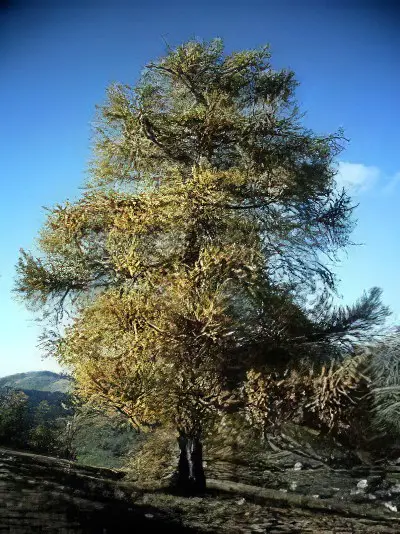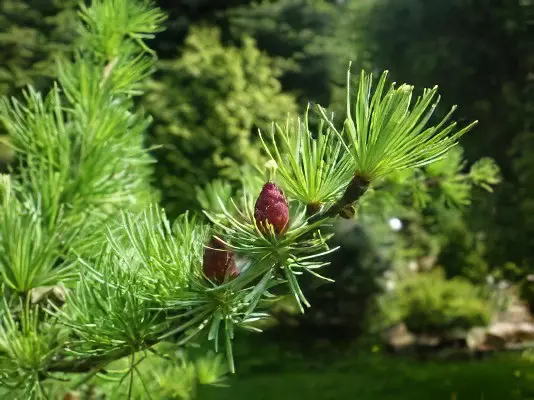Contents
Useful properties and application of Siberian larch
Useful properties of larch

The composition of larch includes essential oil, ascorbic acid, tannins, anthocyanins, gum, flavanols, organic acids. Needles, young shoots, resin, wood, and buds are used as medicinal raw materials. Pine needles are harvested throughout the summer, but it is better to collect it in late June and early August, when the content of vitamin C in the raw material increases. Young shoots and buds are harvested in the spring, resin is obtained by cutting during the growing season, it contains essential oil and rosin , a large amount of abietic acid.
The use of larch
In folk medicine, the needles of the tree are used to make a drink used to quench thirst and as a prophylactic against many diseases. Pine needles are suitable for making salads, which form the basis of dietary nutrition. Larch sponge is used as a laxative and hemostatic agent. Essential oil is used to make ointments, plasters, and in its pure form it is effective as an external remedy for rheumatism, gout, neuralgia and other diseases.
Inhalations of essential oil in folk medicine are prescribed as an antibacterial agent for gangrene of the lungs and catarrh of the upper respiratory tract, bronchitis. Infusions of the bark and shoots are recommended for the treatment of hernia, infusion of needles is used to treat hypermenorrhea. From a toothache, a turpentine compress applied to the cheek helps well; with sciatica, such a compress is additionally covered with a hot heating pad. Baths with infusion of fresh branches are effective for gout. An infusion of pine needles is used for colds with coughs and constipation. Infusions from the bark or needles are an effective remedy for bleeding gums.
Infusion: 20 g of fresh needles must be poured with a glass of cold milk, boiled for 6-7 minutes over low heat, insisted for at least an hour and strained. Take 3 tablespoons of infusion half an hour before meals three times a day.
larch cone
A larch cone looks like a lifeless black rose, and this resemblance is often used by some craft lovers for their own purposes, combining “eternal” bouquets with them. Cones are divided into several types: male – short-lived, dispersing pollen – and female – hard, scaly, sticking up. After the seeds spill out, they become woody and remain on the branches for another 2–3 years. This raw material is part of the medicinal products.
From green cones produce honey, collecting them in May before ripening. It is used for asthma, gastrointestinal diseases, physical or mental exhaustion.
larch seeds
The plant reproduces by seeds ripening in cones, and they are of great value. In clean, close stands, when the distance between plants is small, and the age of the trees reaches 60–100 years, they are of the best quality. They differ from pine trees in low germination and light color. Sometimes the seeds germinate only in the second year, so it is recommended to soak the planting material for two weeks in clean water. Then the soil is prepared by mixing it with sand and sawdust.
larch needles
Larch needles are narrow, soft, straight or curved, 3–4 cm long, 1–1,5 mm wide, bloom in early spring, turn yellow in October. It has a high photosynthesis productivity. Beam needles are of primary importance in the physiological functions of the tree and in the addition of the crown (90% of the total mass of needles). The needles contain essential oil.
For medicinal purposes, raw materials are used to prepare infusions, refreshing drinks, decoctions. These remedies help with bleeding gums, toothache and colds. When coughing, for example, you can boil the needles with milk and breathe over the broth.
larch fruits
The fruits of the plant are finally formed in September-October and have the form of small cones. They grow seeds. During full ripening, the scales on the fruits open, and the seeds fall to the ground. Most often, the fruits are used in the medical and industrial sectors. For medicinal purposes, they are used as ingredients for the preparation of various decoctions, infusions, ointments and other medicinal preparations. They are also good for making souvenirs and arranging bouquets.
Larch bark
The bark near the trunk and on large larch branches is brown, thick, the outer layer is with deep cracks. In old trees, the bark thickness can reach 10 cm or more. Harvested raw materials are used for medicinal purposes and in the chemical industry, making dyes from it. The bark is a source of medical and food pectin, as well as other beneficial substances. It contains lipids in the form of wax, related to esters of ferulic acid.
Infusions of the bark are used as an external agent in the treatment of abscesses and purulent wounds, trophic ulcers and hemorrhoids. It is a good remedy for treating prostatitis, cysts and skin cancer. Modern American scientists have studied the medicinal properties of the bark and found that it contains a huge amount of arabinogalactan, an extract that increases the body’s immunity.
Larch varieties

There are about 20 varieties of this woody plant. Outwardly, they are very similar, but there are dwarf varieties. Their needles bloom in early spring, and in autumn they turn into pale lemon and golden orange. Trees tolerate winter and spring frosts well. They are light-requiring and low-acid soil is suitable for them.
Varieties obtained from European, Siberian and kaempfera larch are often planted in parks and gardens. Trees with a dangling crown have gained wide popularity. They form shocks with numerous dense shoots descending.
Siberian larch. Most often, this particular plant variety is cultivated, which differs mainly in the size of the cones and the number of scales on them. The cones are large (up to 5 cm), the bark is dark, the tree itself is stocky and powerful, reaching a height of 40 m. This frost-resistant, photophilous and wind-resistant plant does not require high soil and air humidity.
The tree develops quickly on various types of soil, but prefers calcareous. It tolerates drought better than other species, is resistant to pests and diseases, and grows well in urban environments. Propagated by seeds. Siberian larch is widespread from the east of the Arkhangelsk region to Altai and Yenisei.
Coniferous larch. This is one of the most valuable industrial varieties. The tree has dense, durable wood, growing up to 50 m. Some specimens can live up to 500 years. This is the only coniferous tree that drops its needles for the winter, but the seedlings retain their greenery throughout the year. This ability was formed as a result of adaptation to the harsh climatic conditions of the environment. This species grows in the mountains of Europe, in the Carpathians, in the Asian part of Russia.
Dahurian larch. In the Far East, this is the most common type of coniferous trees. In favorable conditions, they reach a height of 25–30 m. Their bark is red, very thick in old trees. Young shoots are straw-colored, pubescent or glabrous. The needles are light green, smooth above, ribbed below. Cones are small, oval. Blooming and flowering of buds occurs almost simultaneously – at the end of April or in the first half of May.
Cones ripen in late August and early September. In dry weather, they open immediately. This species is adapted to the most severe conditions. It grows on high mountains, in lowlands, in river valleys, inhabits stony soils, swampy and peaty places, including those with shallow permafrost.
Japanese larch. This is a fast-growing beautiful tree up to 35 m high. Long, thick, almost horizontal branches form a wide pyramidal crown. The trunk is covered with relatively thin red bark. Young shoots have a reddish-gray color, the bark of old branches is dark brown, slightly shiny. The needles are blue-green, up to 5 cm long.
Young cones are yellowish, round, covered with leathery scales. In autumn, the needles turn bright yellow, creating beautiful bright spots in the plantings.
This species usually does not suffer from frost. Demanding on soils, prefers clay and loamy places. The plant is photophilous, develops well in the conditions of the city. Japanese larch grows in Japan on the island of Honshu on the dry sunny slopes of the mountains.
Contraindications to the use of larch
Her preparations are contraindicated in case of individual intolerance to coniferous oils, with peptic ulcer of the stomach and intestines. It is also undesirable to use decoctions and infusions from pine needles after strokes and heart attacks, with severe pathology of the central nervous system. Larch is contraindicated during pregnancy.









